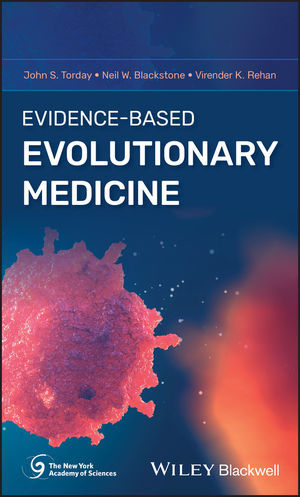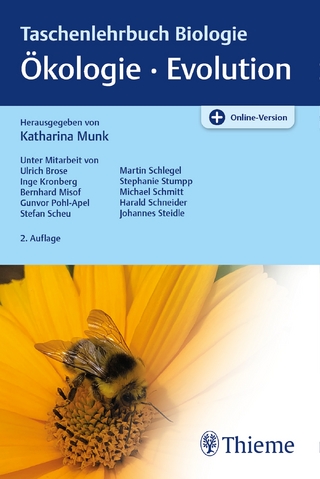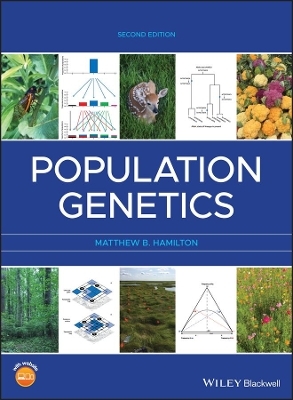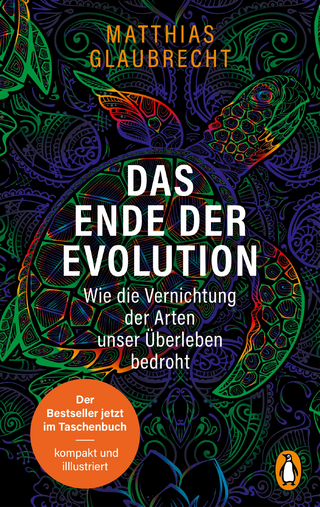
Evidence-Based Evolutionary Medicine
John Wiley & Sons Inc (Verlag)
978-1-118-83837-2 (ISBN)
»Evidence-Based Evolutionary Medicine« offers a comprehensive review of the burgeoning field of evolutionary medicine and explores vital topics such as evolution, ecology, and aging as they relate to mainstream medicine. The text integrates Darwinian principles and evidence-based medicine in order to offer a clear picture of the underlying principles that reflect how and why organisms have evolved on a cellular level.
The authors—noted authorities in their respective fields—address evolutionary medicine from a developmental cell-molecular perspective. They explore the first principles of physiology that explain the generation of existing tissues, organs, and organ systems. The text offers an understanding of the overall biology as a vertically integrated whole, from unicellular to multicellular organisms. In addition, it addresses clinical diagnostic and therapeutic approaches, both traditional and cell-homeostatic. This groundbreaking text:
• Offers a much-needed, logical, and fundamental approach to biology and medicine
• Provides a clear explanation of complex physiology and pathophysiology
• Integrates topics like evolution, ecology and aging into mainstream medicine, making them more relevant
• Contains the first evidence-based text on evolutionary medicine
Written for medical and graduate students in biology, physiology, anatomy, endocrinology, reproductive biology, medicine, pathology, systems biology, this vital resource offers a unique text of both biology as an integrated whole with universal properties; and of medicine seeing the individual as a whole, not an inventory of parts and diseases.
John S. Torday is a Professor of Pediatrics at UCLA, USA.
Neil W. Blackstone is a Professor in the Department of Biological Sciences at Northern Illinois University, USA.
Virender K. Rehan is a Professor of Pediatrics at UCLA, USA.
Preface xiii
1 A Brief History of Evolutionary Thinking 1
Summary 1
Introduction 2
Darwin 3
Darwin’s Theory 6
The Modern Synthesis 7
The Darkest Chapter 9
Conclusions 14
References 14
2 Outlining the Major Transitions in the History of Life 17
Summary 17
Introduction 18
The Major Transitions 20
Conclusions 29
References 30
3 One Central Mystery: Why Did Eukaryotes Only Evolve Once? 31
Summary 31
Introduction 32
Conclusions 45
References 45
4 A Levels‐of‐Selection View of Evolutionary Physiology 49
Summary 49
Conclusions 59
References 59
5 The Cell as the Smallest Functional Unit of Biology/Physiology 63
Summary 63
In the Beginning 64
The Advent of Multicellularity 65
Evolution: Cellular Style 69
The Water–Land Transition and Vertebrate Evolution 70
The Cellular Approach to Evolution Is Predictive 74
We Are Not Just in This Environment, We Are of It 77
Bioethics Based on Evolutionary Ontology and Epistemology, Not Descriptive Phenotypes, and Genes 78
The Theory of Everything (Toe) 79
Coda 81
References 81
6 Development of Tissues and Organs 83
Summary 83
Introduction 83
Lung Alveolar Morphogenesis 85
Parathyroid Hormone‐Related Protein 86
Stretch‐Induced Cell–Cell Interactions 88
References 89
7 When Homeostasis Fails 91
Summary 91
Introduction 91
Peroxisome Proliferator Activated Receptor Gamma as a Connection to the Evolution of the LIF 93
PPAR, Statins, and TOR as Mechanisms for Homeostasis 93
Homeostatic Control of What? 93
Pleiotropy: The Deus ex Machina (Ghost in the Machine) 95
Rubik’s Cube as a Metaphor for Pleiotropic Evolution 96
The Lung as the Prototypical Pleiotropic Mechanism 99
The Lung as an Interactive Barrier: Homolog of the Plasma Membrane, Skin, and Brain 102
NKX2.1, Thyroid, Pituitary, and Lung Pleiotropy 104
The Phylogeny of the Thyroid 105
An Evolutionary Vertical Integration of the Phylogeny and Ontogeny of the Thyroid 105
A Retrospective Understanding of Evolution 107
Denouement 109
Conclusions 111
References 112
8 Wnt Signaling During Development 113
Summary 113
Introduction 113
Role of Growth Factors in Alveolar Homeostasis 114
The Kidney Glomerulus as a Homolog of the Lung Alveolus 116
Pathologic Consequences of Failed Paracrine Signaling 117
Reference 117
9 Integrated Regulation of Homeostasis – Vascular, Nervous, Endocrine, Neuroendocrine, Autonomic 119
Summary 119
Introduction 119
Water–Land Transition as the Catalyst for Vertebrate Evolution 121
Parathyroid Hormone‐Related Protein Signaling Is Key to Understanding the Evolution of the Lung 121
The Physics of Lung Evolution 122
Functional Homology between Membrane Lipids and Oxygenation 124
Atmospheric Oxygen, Physiologic Stress, Gene Duplication, and Lung Evolution 125
Duplication of the Adrenergic Receptor and the Glucocorticoid Receptor Genes 127
Evolution of Endothermy/Homeothermy as Evidence for the Effect of Stress on Vertebrate Physiologic Evolution 127
Hibernation as Reverse Evolution 129
Predictive Power of the Cellular–Molecular Approach to Evolution 131
Conclusions 133
References 136
10 Endogenous and Exogenous Mechanisms for Healing 137
Summary 137
Introduction 138
Endogenous Mechanisms for Healing 138
A Fine Homeostatic Balance between the
Differentiated Interstitial Fibroblast and the Myofibroblast 138
Universality of Wnt/‐catenin in Myofibroblast Proliferation and Scarring: DKK, Shh, Alphabet Soup 140
Prostanoids, Homeostasis, and Regeneration 140
PGJ(2) 141
ApoE4 143
Evolutionary versus Traditional Medicine 144
Exogenous Mechanisms for Healing Using Evolutionary Principles 145
Summary 145
Cholesterol and Homeostasis 145
Pathophysiology of Hypercholesterolemia 145
Statins as Anti‐Inflammatory Agents 146
PPAR and Homeostasis 146
TOR and Homeostasis 148
References 148
11 Systems Biology as Recapitulation of Ontogeny and Phylogeny 151
Summary 151
Introduction 151
A Paradigm Shift in Evolution 152
Endothermy as “Proof of Principle” for the Evolution of Serial Exaptations 154
Endothermy Defies Physics, Fostering Migration 155
Conclusions 157
References 158
12 Terminal Addition as Physiologic Homeostasis and Regeneration, or Evolutionary Medicine 159
Summary 159
Introduction 160
Conflicting Viewpoints 161
Terminal Addition as a Perpetual Cellular Link with the Environment 163
Terminal Addition as Layered Cell–Cell Signaling 164
Epigenetic Impacts and Terminal Addition 167
Physiologic Stress, Vascular Shear Stress, Radical Oxygen Species, and Mutation within Constraints = The Mechanism of Terminal Addition 168
Homeobox Genes, Colinearity, and Terminal Addition 169
The Alveolar Lipofibroblast as Terminal Addition 170
The Participation of Glomerular Mesangial Cells 170
PTHrP Effects on the Anterior Pituitary, Adrenal Cortex, and Adrenal Medulla 171
Catecholamines, Lung, and Heart Biology 171
Oxytocin, Endothermy, and the Retina 171
Central Nervous System 172
Terminal Addition, “Reverse Evolution,” and Evolutionary Medicine 172
Discussion 173
Terminal Addition: The Fundament of Haeckel’s Biogenetic Law 173
Somewhere between Gene and Phenotype Lies the Process of Evolution 174
Conclusions 178
References 179
13 Phantom Limbs: Imagination and Epigenetics 181
Summary 181
Introduction 181
Background to Phantom Limb Sensation 182
Relevance of Phantom Limb Sensation to Terminal Addition 183
Phantom Limb Sensation as Non‐Localization 183
Limbs and Hearts 184
Relationship of Limbs to Bipedalism and the Evolution of Birds and Mammals 185
Of Limbs and Consciousness 186
Life as Fractals 186
Consciousness, the Epitome of the Continuum from Inanimate to Animate 188
References 188
14 Man’s Place in the Universe 191
Summary 191
Introduction 192
Anthropomorphisms Subvert the Biologic Imperative to Cooperate 193
Euphysiology 193
References 200
15 Evolution, Deception, and Public Health 203
Summary 203
Part I. Deception Is Deceiving: The Exception that Proves the Rule 203
Introduction 204
In the Beginning 204
Epigenetics and Niche Construction 205
The Deception Proves the Rule 205
Our Own Personal Heliocentrism 206
Deception and Social Pathology 207
Physiologic Stress 208
Ambiguities in Biology 211
Part II. Resolution of the Ambiguities by Assimilating the Deception 214
Introduction 214
The Cell as the First Niche Construction –
Self‐Organization Overcomes the Ambiguity 214
The Evolution of Endothermy as Internal Niche Construction; or, Self‐Organization Overcomes Biologic Ambiguities 215
Stress‐Induced Evolution of Endothermy by Stepwise Changes in Physiology Predicts Bipedalism, Evolution of the Avian and Hominid Forelimbs, and Higher Consciousness 217
Cold Stress and DRD4–7: Did Risk‐Taking Drive Us Out of Africa? 218
How Androgens Act to Reduce Ambiguities of Life 220
How Art Seemingly Resolves the Deception of Life 221
How Music Resolves the Deception of Life 221
Literature (Deceptively) Resolves the Ambiguities of Life 222
Liturgy Resolves the Ambiguities of Life: Back to the Garden? 222
Part III. Deception and Public Health 222
Cognitive Dissonance: Scientific Principles, Disease, and Health 223
Part IV. Prediction: Bioethics Based on First Principles of Physiology 224
References 226
Index
| Erscheinungsdatum | 03.10.2018 |
|---|---|
| Verlagsort | New York |
| Sprache | englisch |
| Maße | 149 x 214 mm |
| Gewicht | 482 g |
| Einbandart | gebunden |
| Themenwelt | Medizin / Pharmazie ► Allgemeines / Lexika |
| Medizin / Pharmazie ► Medizinische Fachgebiete | |
| Naturwissenschaften ► Biologie ► Evolution | |
| ISBN-10 | 1-118-83837-8 / 1118838378 |
| ISBN-13 | 978-1-118-83837-2 / 9781118838372 |
| Zustand | Neuware |
| Informationen gemäß Produktsicherheitsverordnung (GPSR) | |
| Haben Sie eine Frage zum Produkt? |
aus dem Bereich


